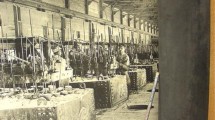Conclusions
-
1.
Wide-pore catalysts have been synthesized under laboratory conditions; with these catalysts, with lower contents of active metals, considerably better stabilities in desulfurization capability can be obtained. The operating life of these catalysts for a given degree of desulfurization, when processing deasphalted Arlan residuum, is more than twice that for narrow-pore catalysts.
-
2.
It has been shown that the efficiency of utilizing the active metals in hydrodesulfurization catalysts depends to a considerable degree on the method of preparing the aluminum oxide support.
Similar content being viewed by others
Literature cited
J. C. Vlugter and P. Van't Spijker, Eighth World Petrol. Congr., Moscow (1971), Proc.,4, 159.
Sixth World Petrol. Congr. (Frankfurt, 1963), Proc. [Russian translation], TsNIITÉNeftegaz, Moscow (1965), p. 106.
B. F. Morozov, G. A. Berg, and V. I. Sokolova, Neftepererab. Neftekhim., No. 4, 53 (1969).
Author information
Authors and Affiliations
Additional information
Translated from Khimiya i Tekhnologiya Topliv i Masel, No. 1, pp. 7–11, January, 1975.
Rights and permissions
About this article
Cite this article
Zaitova, A.Y., Berg, G.A., Volkova, L.I. et al. Development of hydrodesulfurization catalysts for residual petroleum feedstocks. Chem Technol Fuels Oils 11, 9–13 (1975). https://doi.org/10.1007/BF00717303
Issue Date:
DOI: https://doi.org/10.1007/BF00717303




